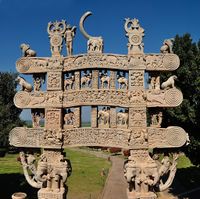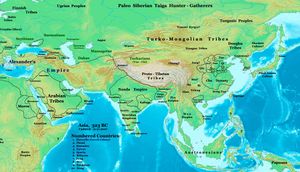امبراطورية ناندا
أسرة ناندا نشأت من منطقة ماگادا في الهند القديمة أثناء القرن الرابع ق.م. واستمرت بين 345–321 ق.م. في أقصى اتساعها، امتدت امبراطورية ناندا من البنغال في الشرق، إلى منطقة الپنجاب في الغرب وامتدت جنوباً حتى سلسلة جبال ڤينديا.[2] حكام هذه الأسرة اشتهروا بثرائهم الفاحش. امبراطورية ناندا احتلها لاحقاً چاندراگوپتا موريا، الذي أسس امبراطورية موريا.
. . . . . . . . . . . . . . . . . . . . . . . . . . . . . . . . . . . . . . . . . . . . . . . . . . . . . . . . . . . . . . . . . . . . . . . . . . . . . . . . . . . . . . . . . . . . . . . . . . . . . . . . . . . . . . . . . . . . . . . . . . . . . . . . . . . . . . . . . . . . . . . . . . . . . . . . . . . . . . . . . . . . . . . .
تأسيس الأسرة
مهاپادما ناندا, who has been described in the Puranas as "the destroyer of all the Kshatriyas",[3] defeated many other kingdoms, including the Panchalas, Kasis, Haihayas, Kalingas,[أ] Asmakas, كورو، Maithilas, Surasenas and the Vitihotras; to name a few.[6] He expanded his territory south of the Vindhya Range into the هضبة الدكن. The Nandas, who usurped the throne of the أسرة شيشوناگا ح. 345 ق.م.،[7] were thought to be of low origin.[8] He was the son of Mahanandin, and a Shudra mother.[9][3]
العسكرية
بنى ملوك ناندا على الأسس التي أرساها سابقوهم الهاريانكا والشيشوناگا لخلق أول امبراطورية عظيمة في شمال الهند.[1] To achieve this objective they built a vast army, consisting of 200,000 infantry, 20,000 cavalry, 2,000 war chariots and 3,000 war elephants (at the lowest estimates).[10][11][12] According to the Greek historian Plutarch, the size of the Nanda army was even larger, numbering 200,000 infantry, 80,000 cavalry, 8,000 war chariots, and 6,000 war elephants.[11][13] However, the Nandas never had the opportunity to see their army up against Alexander, who invaded North-western India at the time of Dhana Nanda, since Alexander was forced to confine his campaign to the plains of Punjab and Sindh, for his forces, mutinied at the river Beas and refused to go any further upon encountering "the 4000 well trained and well equipped war elephants of the Gangaridei (Nanda)" حسب ديودورس الصقلي.[11][14]
A possible indication of Nanda military victories in Kalinga is suggested by the later Hathigumpha inscription of Kharavela, which mentions a King named Nanda building a canal and conquering a place. The existence of a place called Nau Nand Dehra (Nanded) on the Godavari is taken by some scholars يعكس حكم الناندا على الدكن. The evidence for the extension of Nanda rule into trans-Vindhyan India is not, however, strong.[1]
الثروة

The Nandas were also renowned for their immense wealth. They undertook irrigation projects and invented standardized measures for trade across their empire, and they ruled with the assistance of many ministers.[أ] The Nanda Dynasty was also mentioned in the ancient Sangam literature of the Tamil people. The famous Tamil poet Mamulanar of the Sangam literature described the capital city Pataliputra of the Nanda Dynasty and the wealth and treasure that was accumulated by the great Nanda rulers.[15] Their unpopularity, possibly due to their "financial extortion", facilitated a revolution, leading to their overthrow by Chandragupta Maurya and Kautilya. Nevertheless, "the greatness [...] attained in the Maurya Age would hardly have been possible but for the achievements of their predecessors", the Nandas.[أ]
قائمة حكام ناندا
The Mahabodhivamsa lists the following as the nine Nanda kings:[1]
- مهاپادما ناندا (Sarvarthasidi)
- Panduka
- Pandugati
- Bhutapala
- Rashtrapala
- Govishanaka
- Dashasiddhaka
- Kaivarta
- دانا ناندا (Agrammes / Xandrames)
البلاط
Jain and Hindu writers refer to a distinguished line of imperial chancellors or advisors of the king from Kalpaka to Sakatala and Rakshasa. The advisors of the king were fewer in number but were most respected on account of their high character and wisdom. They are mentioned by the Greek observers who wrote about conditions in the fourth century BCE. Next to the advisors were the 'generals of the army'. Bhadrasala, one of such generals, is mentioned in the Milinda-Panho.[16]
في الأدب
A passage of the Kathasaritsagara refers to the kataka (camp) of Nanda in Ayodhya.[6]
ملاحظات
- ^ أ ب ت Kalinga (India) شكلت جزءاً من امبراطورية ناندا but subsequently broke free until it was re-conquered by أشوكا موريا، ح. 260 ق.م.[4][5]
الهامش
- ^ أ ب ت ث Upinder Singh 2016, p. 273.
- ^ Mookerji 1988, p. 28–33.
- ^ أ ب Mookerji 1988, p. 8.
- ^ Raychaudhuri & Mukherjee 1996, pp. 204-209.
- ^ Raychaudhuri & Mukherjee 1996, pp. 270-271.
- ^ أ ب Sastri 1988, p. 17.
- ^ Panda 2007, p. 28.
- ^ Mookerji 1988, p. 7.
- ^ Smith 1999, p. 39.
- ^ Mookerji 1988, p. 34.
- ^ أ ب ت Sastri 1988, p. 16.
- ^ Gabriel, Richard A. (30 November 2002), The great armies of antiquity (1.udg. ed.), Westport, Conn. [u.a.]: Praeger, ISBN 9780275978099, http://www.amazon.com/gp/search?index=books&linkCode=qs&keywords=9780275978099
- ^ Raychaudhuri & Mukherjee 1996, pp. 204-210.
- ^ Kaushik, Roy (2015), Military Manpower, Armies and Warfare in South Asia "Warfare, Society and Culture", Routledge, ISBN 1317321286, https://www.routledge.com/products/9781138664586
- ^ The First Spring: The Golden Age of India by Abraham Eraly p.62
- ^ Sastri 1988, p. 15.
المراجع
- Mookerji, Radha Kumud (1988) [first published in 1966], Chandragupta Maurya and his times (4th ed.), Motilal Banarsidass, ISBN 81-208-0433-3, https://books.google.com/books?id=i-y6ZUheQH8C
- Panda, Harihar (2007), Prof. H.C. Raychaudhuri, as a Historian, Northern Book Centre, ISBN 81-7211-210-6, https://books.google.com/books?id=f1XMtc2Q97IC
- Raychaudhuri, H. C.; Mukherjee, B. N. (1996), Political History of Ancient India: From the Accession of Parikshit to the Extinction of the Gupta Dynasty, Oxford University Press
- Sastri, K. A. Nilakanta, ed. (1988), Age of the Nandas and Mauryas (Second ed.), Delhi: Motilal Banarsidass, ISBN 81-208-0465-1, https://books.google.com/books?id=YoAwor58utYC
- Singh, Upinder (2016), A History of Ancient and Early Medieval India: From the Stone Age to the 12th Century, Pearson Education, ISBN 978-93-325-6996-6, https://books.google.co.in/books?id=Pq2iCwAAQBAJ
- Smith, Vincent A. (1999), The Early History of India (third ed.), Atlantic Publishers and distributors, ISBN 978-81-7156-618-1, https://books.google.com/books?id=8XXGhAL1WKcC
| سبقه أسرة شيشوناگا |
أسرة ناندا (345 ق.م.–321 ق.م.) |
تبعه امبراطورية موريا |
| الممالك الوسطى في الهند | ||||||
|---|---|---|---|---|---|---|
| خط زمني والفترة التاريخية |
Northwestern India | Indo-Gangetic Plain | الهند الوسطى | الهند الجنوبية | ||
| Upper Gangetic Plain | Middle Gangetic Plain
|
Lower Gangetic Plain
| ||||
| العصر الحديدي | ||||||
| الثقافة | فترة الڤديك المتأخرة | فترة الڤديك المتأخرة (Brahmin ideology)[أ] |
فترة الڤديك المتأخرة (Kshatriya/Shramanic culture)[ب] |
ما قبل التاريخ | ||
| القرن 6 ق.م. | گاندارا | كورو-Panchala | ماگادا | أديڤاسي (قبائل) | ||
| الثقافة | التأثير الفارسي-اليوناني | "التمدن الثاني" | ما قبل الهند | |||
| القرن 5 ق.م. | (الحكم الفارسي) | Shishunaga dynasty | أديڤاسي (قبائل) | |||
| القرن 4 ق.م. | (الغزوات اليونانية) | امبراطورية ناندا | ||||
| العصر التاريخي | ||||||
| الثقافة | انتشار البوذية | ما قبل التاريخ | Sangam period (300 ق.م. – 200 م) | |||
| القرن 3 ق.م. | امبراطورية مورايا | Early Cholas 46 other small kingdoms in Ancient Thamizhagam | ||||
| الثقافة | الهندوسية ما قبل الكلاسيكية[ت] - "Hindu Synthesis"[ث] (ca. 200 BC - 300 AD)[ج][ح] الملاحم - Puranas - Ramayana - Mahabharata - Bhagavad Gita - Brahma Sutras - Smarta Tradition Mahayana Buddhism |
Sangam period (استمرت) | ||||
| القرن 2 ق.م. | المملكة الهندو-يونانية | امبراطورية شونگا | Early Cholas 46 ممالك أخرى صغيرة في Ancient Thamizhagam | |||
| القرن 1 ق.م. | ||||||
| القرن 1 م | مملكة كونيندا | |||||
| القرن 2 | امبراطورية كوشان | |||||
| القرن 2 | المملكة الكوشانية الساسانية | امبراطورية كوشان | Western Satraps | Kamarupa kingdom | Kalabhra dynasty | |
| الثقافة | "العصر الذهبي للهندوسية"(ح. 320-650 م)[خ] Puranas Co-existence of Hinduism and Buddhism | |||||
| القرن 4 | Kidarites | Gupta Empire | Kalabhra dynasty | |||
| القرن 5 | Hephthalite Empire | Alchon Huns | Kalabhra dynasty | |||
| القرن 6 | Nezak Huns | Maitraka | Adivasi (tribes) | Badami Chalukyas | ||
| الثقافة | Late-Classical Hinduism (ح. 650-1100 م)[د] Advaita Vedanta - Tantra Decline of Buddhism in India | |||||
| القرن 7 | Indo-Sassanids | Vakataka dynasty Empire of Harsha |
Mlechchha dynasty | Adivasi (tribes) | Pandyan Kingdom(Under Kalabhras) | |
| القرن 8 | Kabul Shahi | Pala Empire | Pandyan Kingdom | |||
| القرن 9 | Gurjara-Pratihara | Rashtrakuta dynasty | ||||
| القرن 10 | Ghaznavids | Pala dynasty | Kalyani Chalukyas | |||
مصادر ومراجع الجدول المصادر Sources
| ||||||



